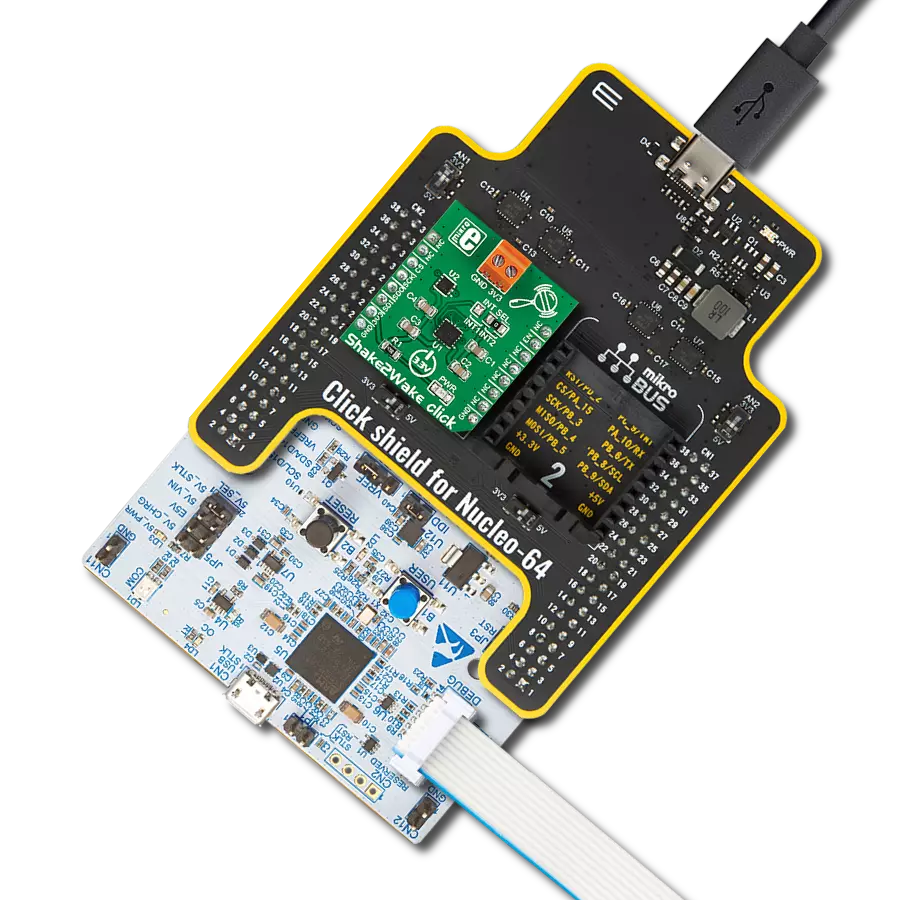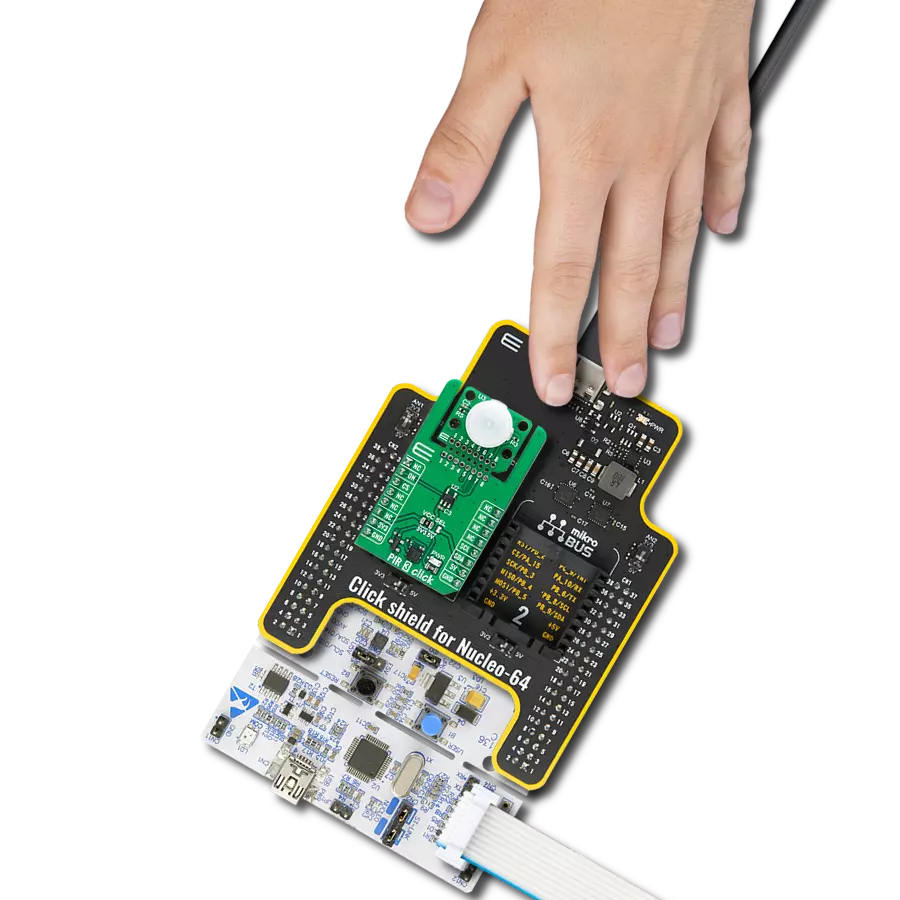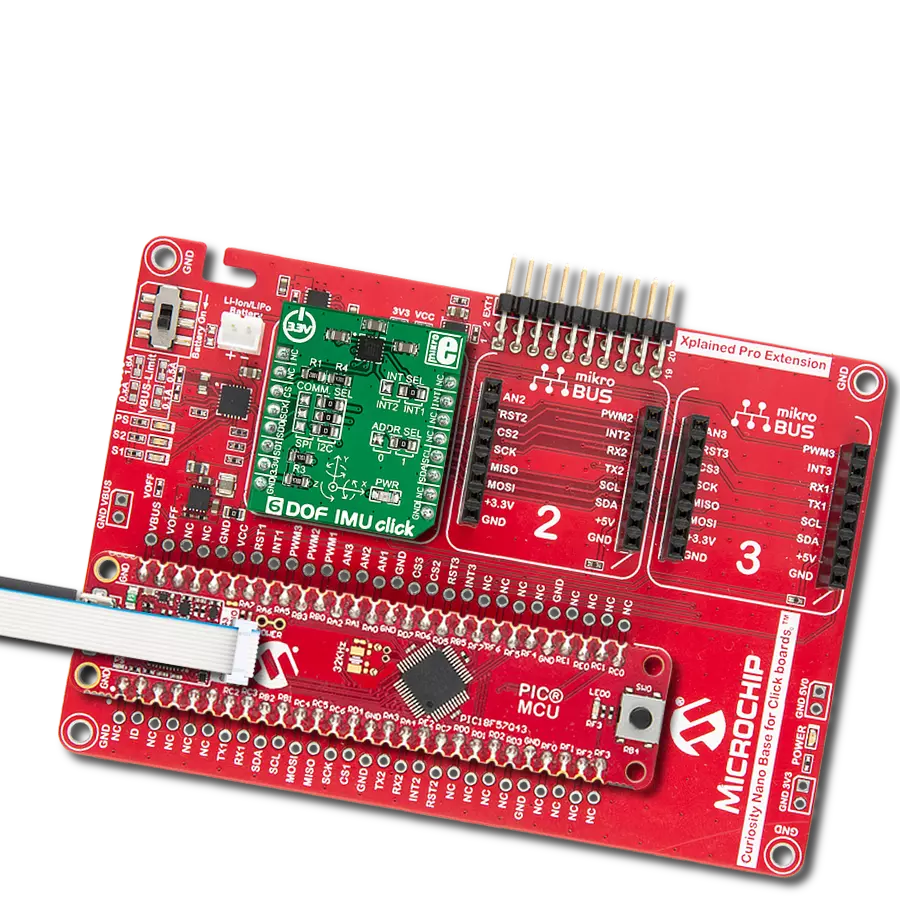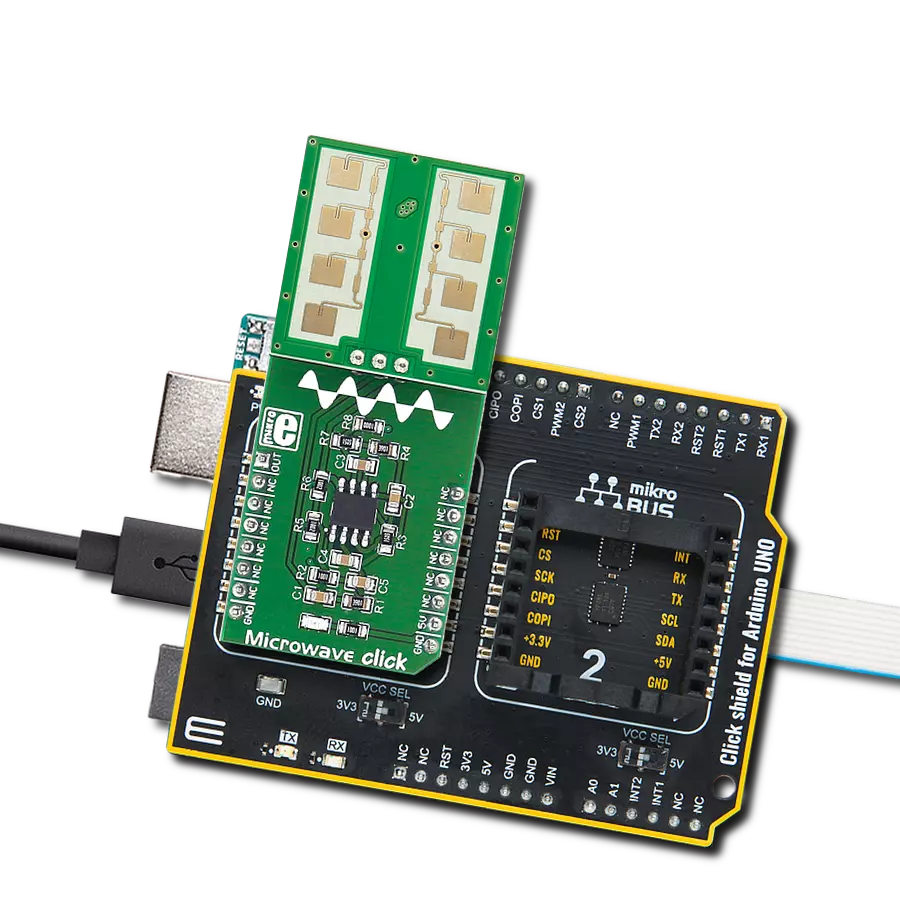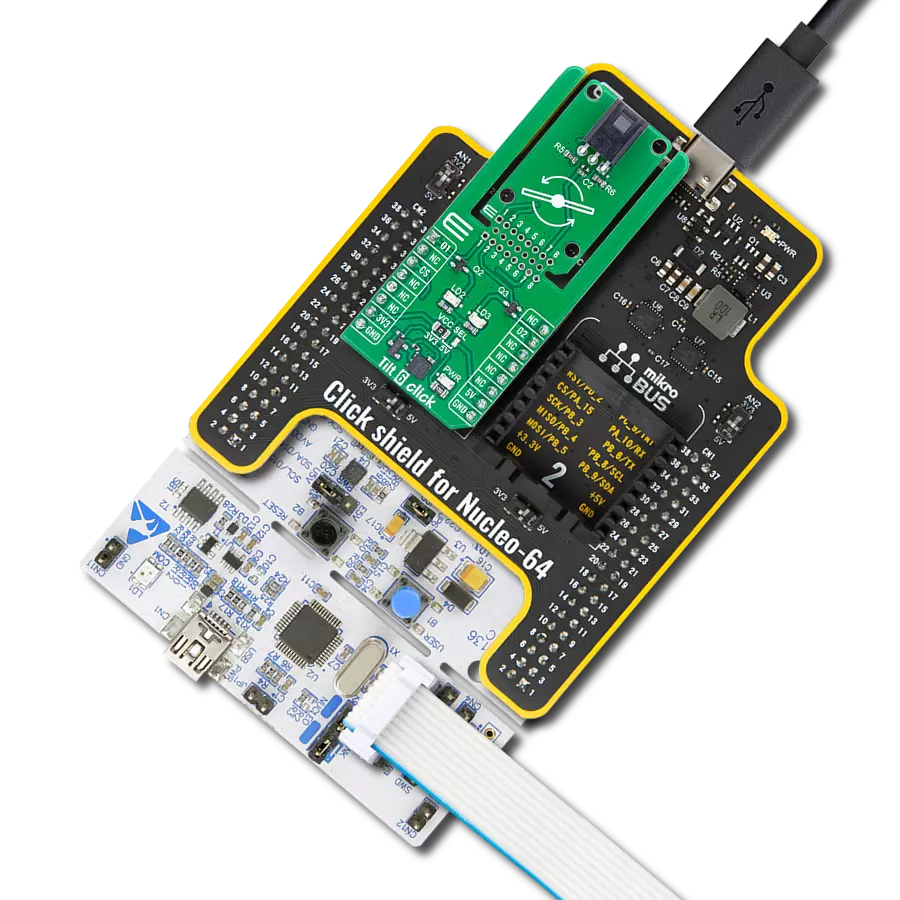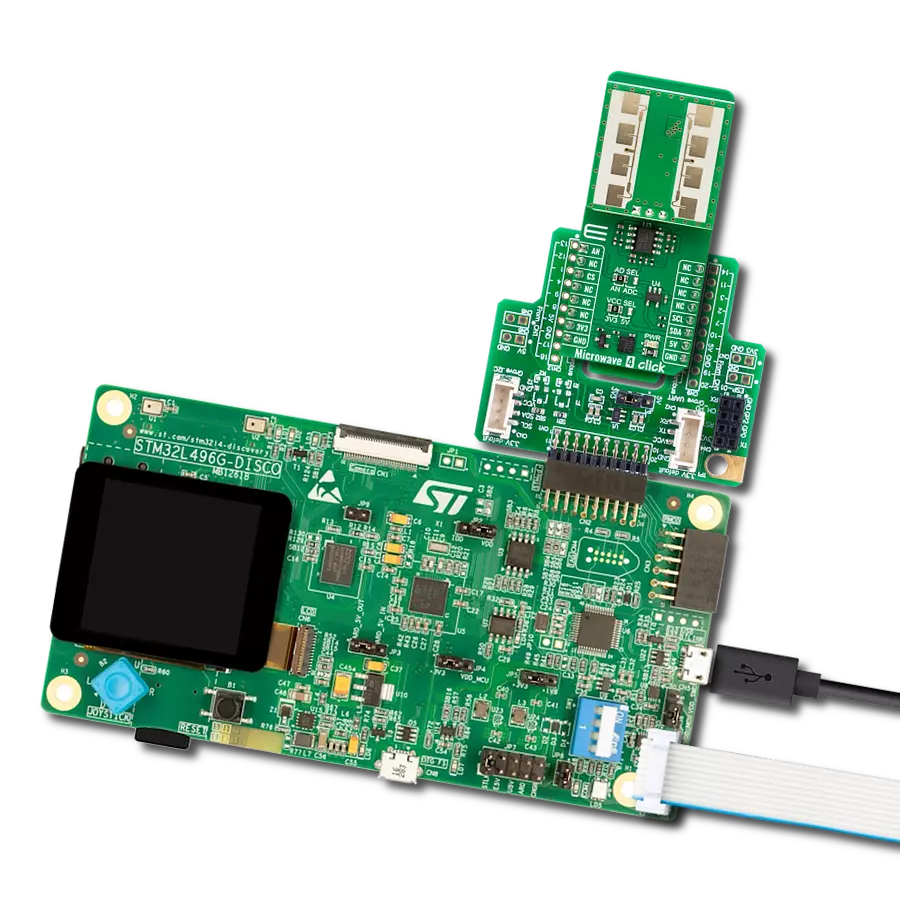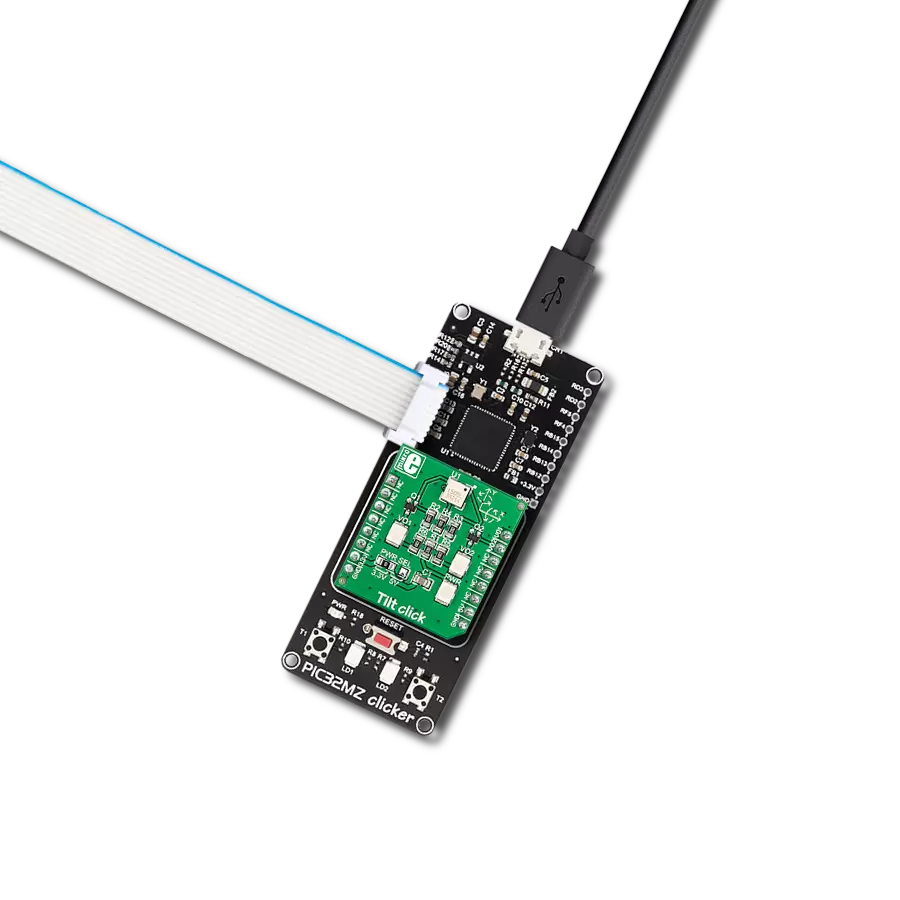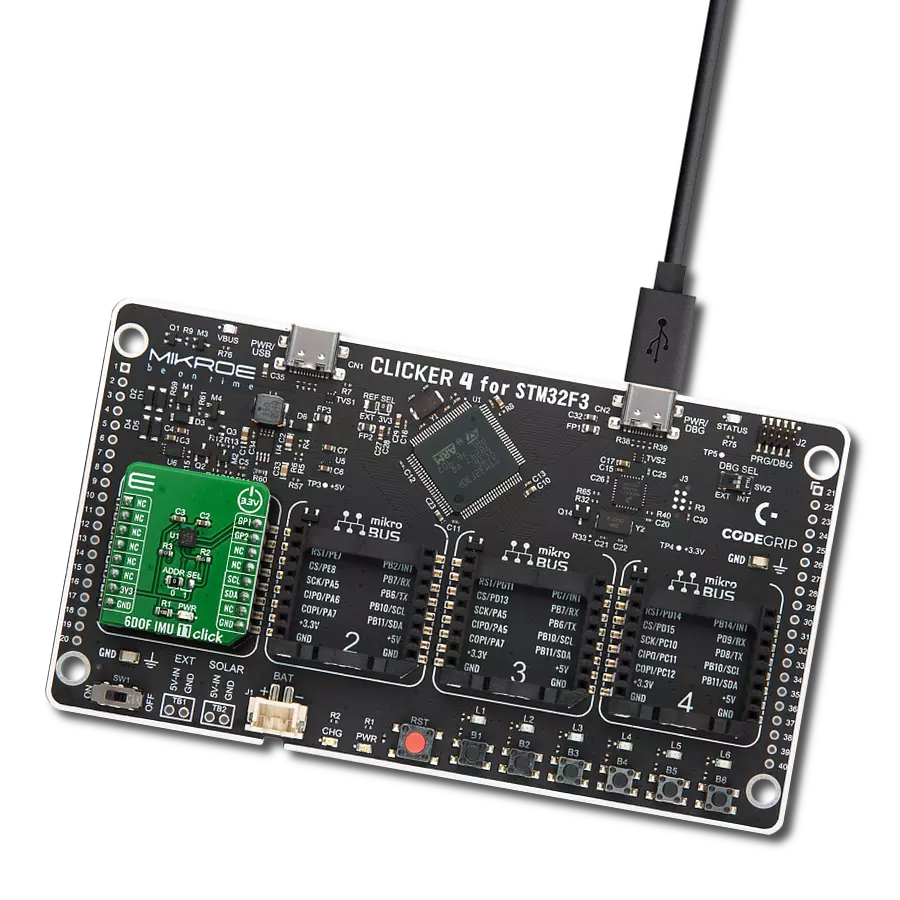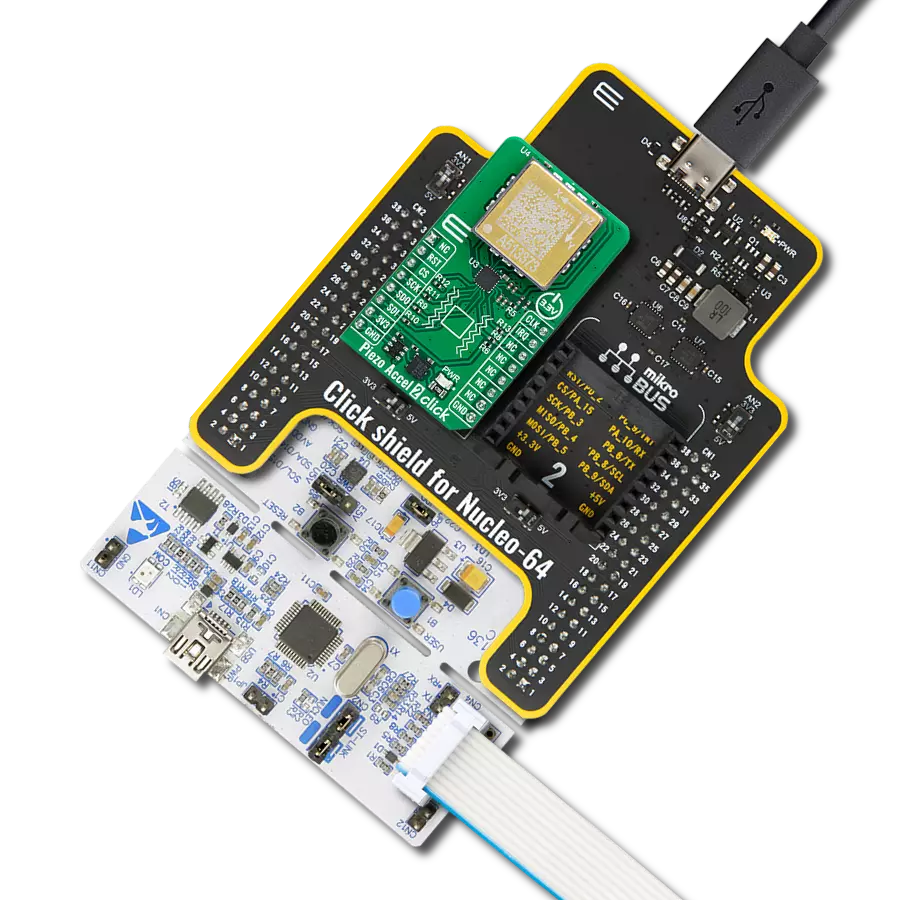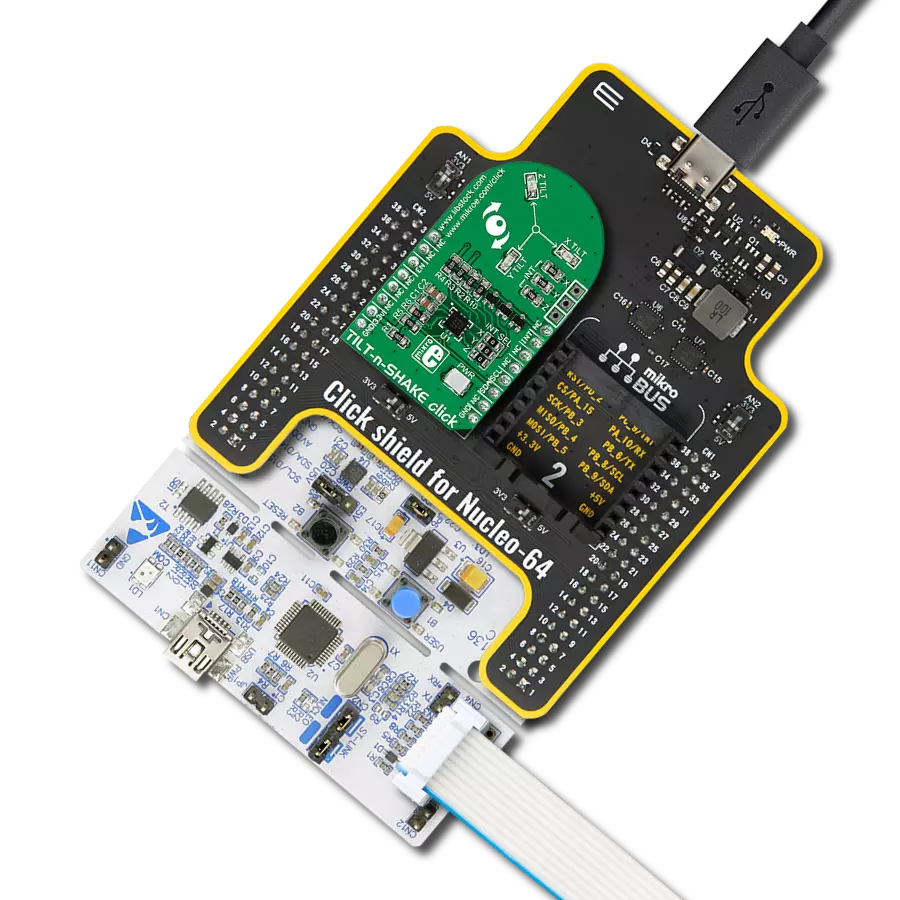Achieve exceptional roll, pitch, and yaw accuracy (1.0º RMS for roll/pitch, 2º RMS for yaw) under dynamic conditions, ensuring stable and controlled movements
A
A
Hardware Overview
How does it work?
XSENS MTi-3 Click is based on the MTi-3, a self-contained Attitude Heading and Reference System (AHRS), Vertical Reference Unit (VRU), and Inertial Measurement Unit (IMU) module from Xsens. The MTi-3 module supports all features of the MTi-1 series, including a 3D accelerometer, a 3D gyroscope, a high-accuracy crystal, a low-power MCU, and it is also a full magnetometer-enhanced AHRS. It can output 3D orientation data, free acceleration, and calibrated sensor data (rate of turn, magnetic field). The MTi-3 is easily configurable for the outputs, depends on the application needs, and can be set to use one of the filter profiles available within the Xsens sensor fusion engine. In this way, the MTi-3 module limits the load and the power consumption on the user application processor. This Click board™ is equipped with a USB type C connector. It allows the module to be powered and configured by a personal computer (PC) using FT230X, a highly integrated USB to UART bridge solution from FTDI, which has been designed to operate efficiently with USB host controllers by using as little bandwidth as possible when compared to the total USB bandwidth available. This module can also be configured easily by the free downloadable Xsens MT Software Suite as an Inertial
Measurement Unit (IMU), Vertical Reference Unit (VRU), or even an Attitude & Heading Reference System (AHRS), which applies Xsens’ powerful Kalman filtering XKF3 Core. The XSENS MTi-3 Click has two power supply pins. The first pin represents the main power supply of the module powered via a low dropout linear regulator AP7331 from Diodes Incorporated that receives a 5V power supply from USB to UART solution and gives 3.3V on its output that is used as the main power supply of the module. The second pin represents the digital supply voltage and is powered by 3.3V directly from the mikroBUS™ socket. This Click board™ communicates with MCU using the UART interface as its default communication interface but also allows the user to use other interfaces, such as SPI and I2C if he wants to configure the module and write the library by himself. The desired interface selection can be performed through the peripheral selection pins by positioning SMD jumpers labeled as PSEL to an appropriate position. The module reads the state of these pins at Start-Up and configures its peripheral interface. To change the selected interface, the logic levels of those pins must be set first, and then the module needs to be reset. The selection between UART/I2C and SPI/I2C interfaces
can be performed by positioning SMD jumpers labeled COMM SEL to an appropriate position. The user can also configure the I2C slave address through the ADD0, ADD1, and ADD2 pins by positioning SMD jumpers labeled ADDR SEL to an appropriate position. Note that all the jumpers must be placed on the same side, or the Click board™ may become unresponsive. Additional functionality routed at RST and AN pins of the mikroBUS™ socket allows the user to use the reset function and receive the latest available data message. Also, this Click board™ has two pins, INT and PWM pins, that can be used in many ways. For example, it can be used as serial UART connections CTS and RTS in UART full-duplex mode or as RX/TX control signals in UART half-duplex mode. Regardless of these functions, the INT pin can also be used as a classic interrupt function. This Click board™ can be operated only with a 3.3V logic voltage level. The board must perform appropriate logic voltage level conversion before using MCUs with different logic levels. Also, it comes equipped with a library containing functions and an example code that can be used as a reference for further development.
Features overview
Development board
Fusion for TIVA v8 is a development board specially designed for the needs of rapid development of embedded applications. It supports a wide range of microcontrollers, such as different 32-bit ARM® Cortex®-M based MCUs from Texas Instruments, regardless of their number of pins, and a broad set of unique functions, such as the first-ever embedded debugger/programmer over a WiFi network. The development board is well organized and designed so that the end-user has all the necessary elements, such as switches, buttons, indicators, connectors, and others, in one place. Thanks to innovative manufacturing technology, Fusion for TIVA v8 provides a fluid and immersive working experience, allowing access
anywhere and under any circumstances at any time. Each part of the Fusion for TIVA v8 development board contains the components necessary for the most efficient operation of the same board. An advanced integrated CODEGRIP programmer/debugger module offers many valuable programming/debugging options, including support for JTAG, SWD, and SWO Trace (Single Wire Output)), and seamless integration with the Mikroe software environment. Besides, it also includes a clean and regulated power supply module for the development board. It can use a wide range of external power sources, including a battery, an external 12V power supply, and a power source via the USB Type-C (USB-C) connector.
Communication options such as USB-UART, USB HOST/DEVICE, CAN (on the MCU card, if supported), and Ethernet is also included. In addition, it also has the well-established mikroBUS™ standard, a standardized socket for the MCU card (SiBRAIN standard), and two display options for the TFT board line of products and character-based LCD. Fusion for TIVA v8 is an integral part of the Mikroe ecosystem for rapid development. Natively supported by Mikroe software tools, it covers many aspects of prototyping and development thanks to a considerable number of different Click boards™ (over a thousand boards), the number of which is growing every day.
Microcontroller Overview
MCU Card / MCU
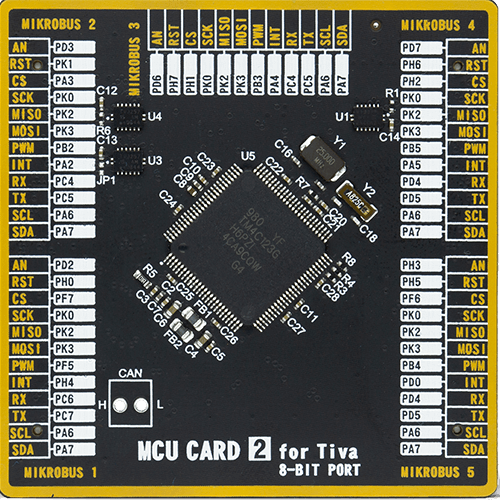
Type
8th Generation
Architecture
ARM Cortex-M4
MCU Memory (KB)
256
Silicon Vendor
Texas Instruments
Pin count
100
RAM (Bytes)
32768
Used MCU Pins
mikroBUS™ mapper
Take a closer look
Click board™ Schematic

Step by step
Project assembly
Track your results in real time
Application Output
1. Application Output - In Debug mode, the 'Application Output' window enables real-time data monitoring, offering direct insight into execution results. Ensure proper data display by configuring the environment correctly using the provided tutorial.

2. UART Terminal - Use the UART Terminal to monitor data transmission via a USB to UART converter, allowing direct communication between the Click board™ and your development system. Configure the baud rate and other serial settings according to your project's requirements to ensure proper functionality. For step-by-step setup instructions, refer to the provided tutorial.
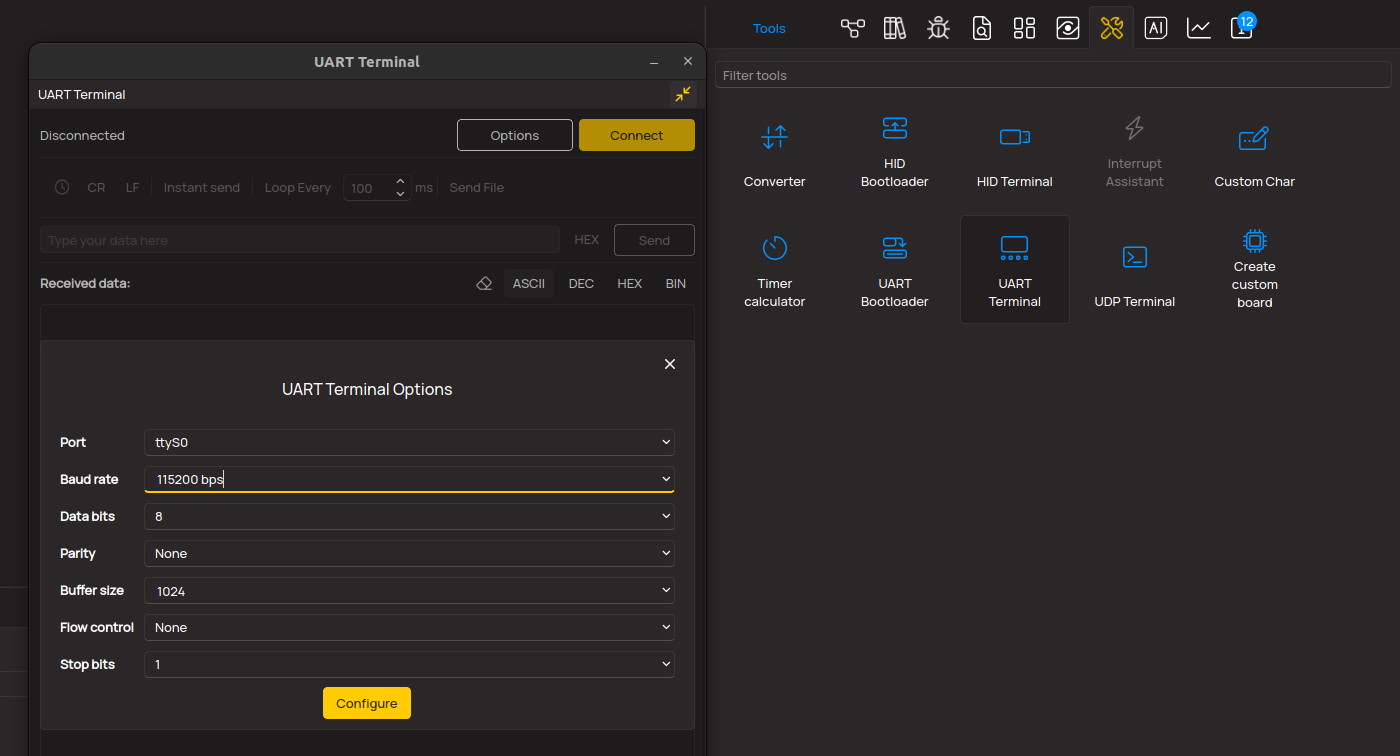
3. Plot Output - The Plot feature offers a powerful way to visualize real-time sensor data, enabling trend analysis, debugging, and comparison of multiple data points. To set it up correctly, follow the provided tutorial, which includes a step-by-step example of using the Plot feature to display Click board™ readings. To use the Plot feature in your code, use the function: plot(*insert_graph_name*, variable_name);. This is a general format, and it is up to the user to replace 'insert_graph_name' with the actual graph name and 'variable_name' with the parameter to be displayed.
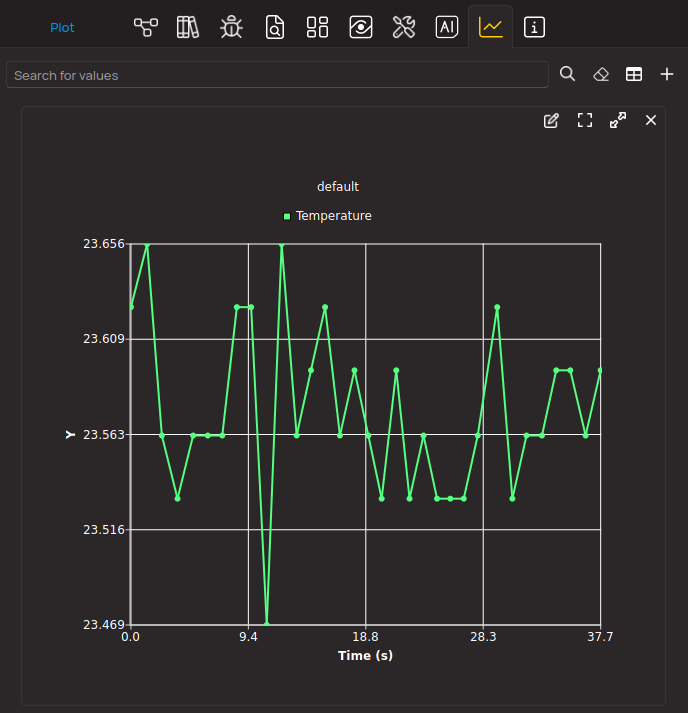
Software Support
Library Description
This library contains API for XSENS MTi-3 Click driver.
Key functions:
xsensmti3_parser- XSENS MTi-3 general parserxsensmti3_get_data- XSENS MTi-3 get Roll, Pitch and Yawxsensmti3_check_package- XSENS MTi-3 checks package
Open Source
Code example
The complete application code and a ready-to-use project are available through the NECTO Studio Package Manager for direct installation in the NECTO Studio. The application code can also be found on the MIKROE GitHub account.
/*!
* @file main.c
* @brief XSENS MTi-3 Click Example.
*
* # Description
* This example reads and processes data from XSENS MTi-3 Clicks.
*
* The demo application is composed of two sections :
*
* ## Application Init
* Initializes driver and wake-up module.
*
* ## Application Task
* Reads the received data and parses it. Shows Roll, Pitch and Yaw data.
*
* ## Additional Function
* - void xsensmti3_process ( void ) - The general process of collecting data the module sends.
*
* @author Mikroe Team
*
*/
#include "board.h"
#include "log.h"
#include "xsensmti3.h"
#define PROCESS_RX_BUFFER_SIZE 200
#define PROCESS_PARSER_BUFFER_SIZE 1000
static xsensmti3_t xsensmti3;
static log_t logger;
static uint8_t current_parser_buf[ PROCESS_PARSER_BUFFER_SIZE ];
static uint8_t parser_buf_cnt;
static uint8_t active_flag;
static uint8_t start_rsp;
static uint16_t rsp_cnt;
static xsensmti3_parse_t parse_data_obj;
static xsensmti3_data_t data_obj;
/**
* @brief XSENS MTi-3 data reading function.
* @details This function reads data from device and concatenates data to application buffer.
* @return Nothing.
* @note None.
*/
static void xsensmti3_process ( void );
void application_init ( void )
{
log_cfg_t log_cfg; /**< Logger config object. */
xsensmti3_cfg_t xsensmti3_cfg; /**< Click config object. */
/**
* Logger initialization.
* Default baud rate: 115200
* Default log level: LOG_LEVEL_DEBUG
* @note If USB_UART_RX and USB_UART_TX
* are defined as HAL_PIN_NC, you will
* need to define them manually for log to work.
* See @b LOG_MAP_USB_UART macro definition for detailed explanation.
*/
LOG_MAP_USB_UART( log_cfg );
log_init( &logger, &log_cfg );
log_info( &logger, " Application Init " );
// Click initialization.
xsensmti3_cfg_setup( &xsensmti3_cfg );
XSENSMTI3_MAP_MIKROBUS( xsensmti3_cfg, MIKROBUS_1 );
if ( UART_ERROR == xsensmti3_init( &xsensmti3, &xsensmti3_cfg ) )
{
log_error( &logger, " Communication init." );
for ( ; ; );
}
log_info( &logger, " Application Task " );
}
void application_task ( void )
{
uint8_t check_data = 0;
uint8_t cnt = 0;
xsensmti3_process( );
// STARTS COLLECTING DATA
if ( active_flag == XSENSMTI3_WAIT_FOR_START )
{
memset( ¤t_parser_buf[ 0 ], 0 , PROCESS_PARSER_BUFFER_SIZE );
parser_buf_cnt = 0;
active_flag = 0;
start_rsp = 0;
rsp_cnt = 0;
active_flag = XSENSMTI3_START_PROCESS;
}
if ( ( parser_buf_cnt > 100 ) && ( active_flag == XSENSMTI3_START_PROCESS ) )
{
active_flag = XSENSMTI3_DATA_PROCESSING;
}
if ( active_flag == XSENSMTI3_DATA_PROCESSING )
{
check_data = xsensmti3_check_package( ¤t_parser_buf[ 0 ], &start_rsp );
if ( check_data == XSENSMTI3_OK )
{
active_flag = XSENSMTI3_PARSER_DATA;
}
else
{
active_flag = XSENSMTI3_WAIT_FOR_START;
}
}
if ( active_flag == XSENSMTI3_PARSER_DATA )
{
xsensmti3_parser( ¤t_parser_buf[ 0 ], start_rsp, &parse_data_obj );
log_printf( &logger, ">> Quaternion data <<\r\n" );
for ( cnt = 0; cnt < 4; cnt++ )
{
log_printf( &logger, ">> Q: %f\r\n", parse_data_obj.quat_obj.quat_data[ cnt ] );
}
log_printf( &logger, "--------------\r\n" );
xsensmti3_get_data( &parse_data_obj.quat_obj, &data_obj );
log_printf( &logger, ">> ROLL: %.4f \r\n", data_obj.roll );
log_printf( &logger, ">> PITCH: %.4f \r\n", data_obj.pitch );
log_printf( &logger, ">> YAW: %.4f \r\n", data_obj.yaw );
active_flag = XSENSMTI3_WAIT_FOR_START;
log_printf( &logger, "--------------\r\n" );
}
}
int main ( void )
{
/* Do not remove this line or clock might not be set correctly. */
#ifdef PREINIT_SUPPORTED
preinit();
#endif
application_init( );
for ( ; ; )
{
application_task( );
}
return 0;
}
static void xsensmti3_process ( void )
{
int32_t rsp_size;
uint8_t uart_rx_buffer[ PROCESS_RX_BUFFER_SIZE ] = { 0 };
rsp_size = xsensmti3_generic_read( &xsensmti3, &uart_rx_buffer, PROCESS_RX_BUFFER_SIZE );
if ( rsp_size > 0 )
{
parser_buf_cnt += rsp_size;
if ( rsp_cnt + rsp_size < PROCESS_PARSER_BUFFER_SIZE )
{
strncat( ¤t_parser_buf[ rsp_cnt ], uart_rx_buffer, rsp_size );
rsp_cnt += rsp_size;
}
else
{
memset( ¤t_parser_buf[ 0 ], 0 , PROCESS_PARSER_BUFFER_SIZE );
parser_buf_cnt = 0;
active_flag = 0;
start_rsp = 0;
rsp_cnt = 0;
}
memset( uart_rx_buffer, 0, PROCESS_RX_BUFFER_SIZE );
}
else
{
Delay_ms ( 100 );
}
}
// ------------------------------------------------------------------------ END


















